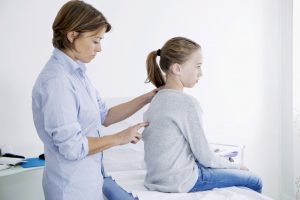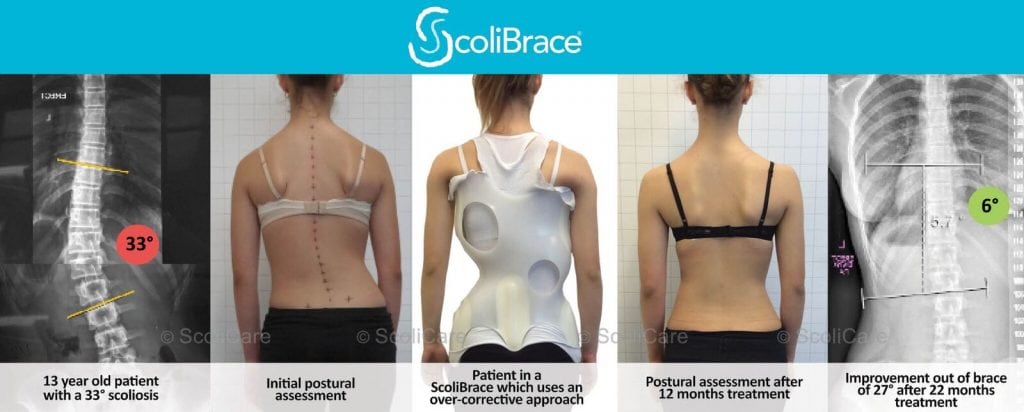
Scoliosis treatment has come a long way since treatments for conditions first emerged at the start of the last century. Today there are more options for scoliosis sufferers than ever before, so a common question we often get is simply – “how should I treat scoliosis in 2021”? Over the next couple of articles, we’ll try to answer this as simply as possible.
Historically, it was thought that surgery was the only way to treat scoliosis – but today there are a number of non-surgical approaches which, when applied by a specialist scoliosis clinician, can treat scoliosis.
The two main treatment methodologies used are exercise-based approaches and bracing. Bracing is the most effective way to reduce a cobb angle (cobb angle is the measurement of scoliotic curve) and avoid surgery. In one recent study of 113 patients, the vast majority achieved a complete curve correction and only 4.9% of patients needed surgery.[i] Results vary by brace – but some studies have shown success rates with bracing as high as 100%.[ii]
Scoliosis specific exercise can be effective in treating smaller curves (generally below 20 degrees) where there is a lower risk of progression, but is probably best used in support of bracing, as a method to address muscular imbalances and postural problems which can often result from scoliosis.
Although the “wait and see” or “observation” approach to scoliosis management is now outdated, it is often still recommended by GP’s and is sadly still the favoured approach within the NHS. Unfortunately, the vast majority of scoliosis cases will progress, so it is better to seek advice from a scoliosis professional wherever possible.
This week, let’s compare the options which are most often known to patients – observation and bracing.
Observation (Wait and see)
Observation is not a treatment for scoliosis, it is simply the act of watching and waiting – however, scoliosis almost never resolves without treatment.
Research has demonstrated that Juvenile scoliosis greater than 30 degrees increases rapidly and presents a 100% prognosis for surgery. Curves from 21 to 30 degrees are more difficult to predict but can frequently end up requiring surgery, or at least causing significant disability.[iii]
Because observation is not a treatment, it most often leads to the patient requiring surgery. By contrast, today, through modern bracing technology, it has been demonstrated that conservative treatment with a brace is highly effective in treating juvenile idiopathic scoliosis. In one recent study of 113 patients, the vast majority achieved a complete curve correction and only 4.9% of patients needed surgery.[iv]
Bracing
Scoliosis braces are the most effective non-surgical method for reducing cobb angle[v] There are many different kinds of scoliosis brace and many work slightly differently, however broadly speaking braces can be classified as active correction braces (which aim to reduce scoliosis by guiding the spine back to correct posture) and passive braces (which aim to prevent scoliosis from developing any further by holding the spine in its current position).
Results vary by brace – but some studies have shown success rates with bracing as high as 100%.[vi]
Scoliosis bracing in children and adolescents is recommended when Cobb angles over 20° are observed and there is a risk of progression as the child grows. For cobb angles under 20°, bracing might still be a preferred treatment option, since (unlike exercise) no conscious effort is necessary from the wearer.
Night-time braces are also an attractive option for single curves not exceeding 35 degrees in magnitude.[vii]
(This article continues next week!)
[i] ‘Brace treatment in juvenile idiopathic scoliosis: a prospective study in accordance with the SRS criteria for bracing studies – SOSORT award 2013 winner‘ Angelo G Aulisa, Vincenzo Guzzanti, Emanuele Marzetti,Marco Giordano, Francesco Falciglia and Lorenzo Aulisa, Scoliosis 2014 9:3 DOI: 10.1186/1748-7161-9-3
[ii] De Giorgi S, Piazzolla A, Tafuri S, Borracci C, Martucci A, De Giorgi G. Chêneau brace for adolescent idiopathic scoliosis: long-term results. Can it prevent surgery? Eur Spine J.2013;22(6):S815–22, and Aulisa AG, Guzzanti V, Perisano C, Marzetti E, Falciglia F, Aulisa L.Treatment of lumbar curves in scoliotic adolescent females with progressive action short brace: a case series based on the Scoliosis Research Society Committee Criteria. Spine (Phila Pa 1976). 2012;37(13):E786-E791.
[iii] Progression risk of idiopathic juvenile scoliosis during pubertal growth, Charles YP, Daures JP, de Rosa V, Diméglio A. Spine 2006 Aug 1;31(17):1933-42.
[iv] ‘Brace treatment in juvenile idiopathic scoliosis: a prospective study in accordance with the SRS criteria for bracing studies – SOSORT award 2013 winner‘ Angelo G Aulisa, Vincenzo Guzzanti, Emanuele Marzetti,Marco Giordano, Francesco Falciglia and Lorenzo Aulisa, Scoliosis 2014 9:3 DOI: 10.1186/1748-7161-9-3
[vi] De Giorgi S, Piazzolla A, Tafuri S, Borracci C, Martucci A, De Giorgi G. Chêneau brace for adolescent idiopathic scoliosis: long-term results. Can it prevent surgery? Eur Spine J.2013;22(6):S815–22, and Aulisa AG, Guzzanti V, Perisano C, Marzetti E, Falciglia F, Aulisa L.Treatment of lumbar curves in scoliotic adolescent females with progressive action short brace: a case series based on the Scoliosis Research Society Committee Criteria. Spine (Phila Pa 1976). 2012;37(13):E786-E791.
[vii] Grivas TB, Rodopoulos GI and Bardakos NV, ‘Biomechanical and clinical perspectives on nighttime bracing for adolescent idiopathic scoliosis‘ Stud Health Technol Inform. 2008;135:274-90.




